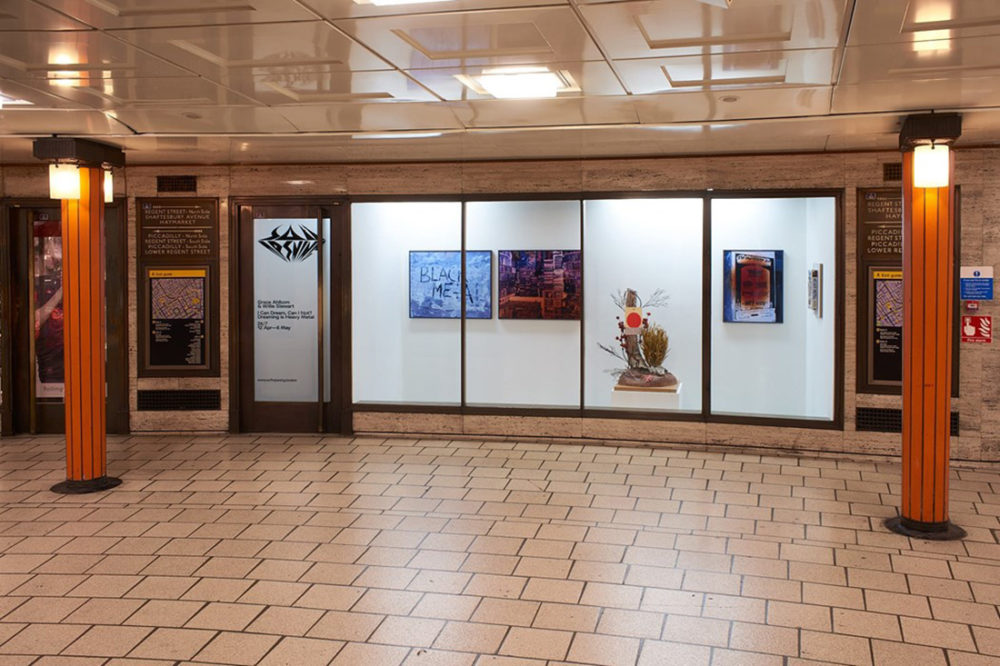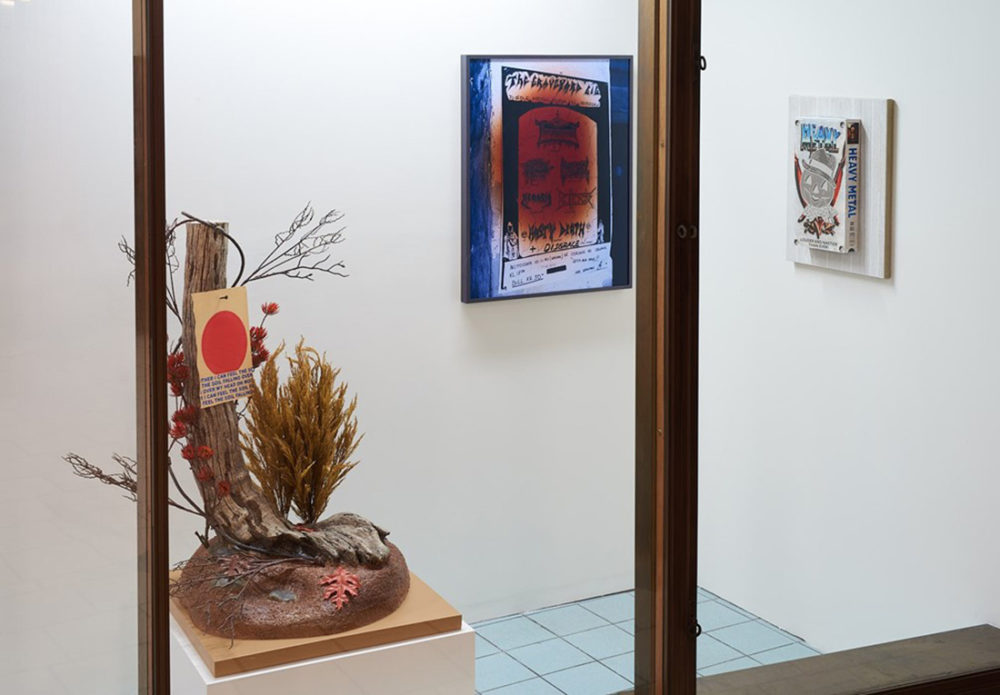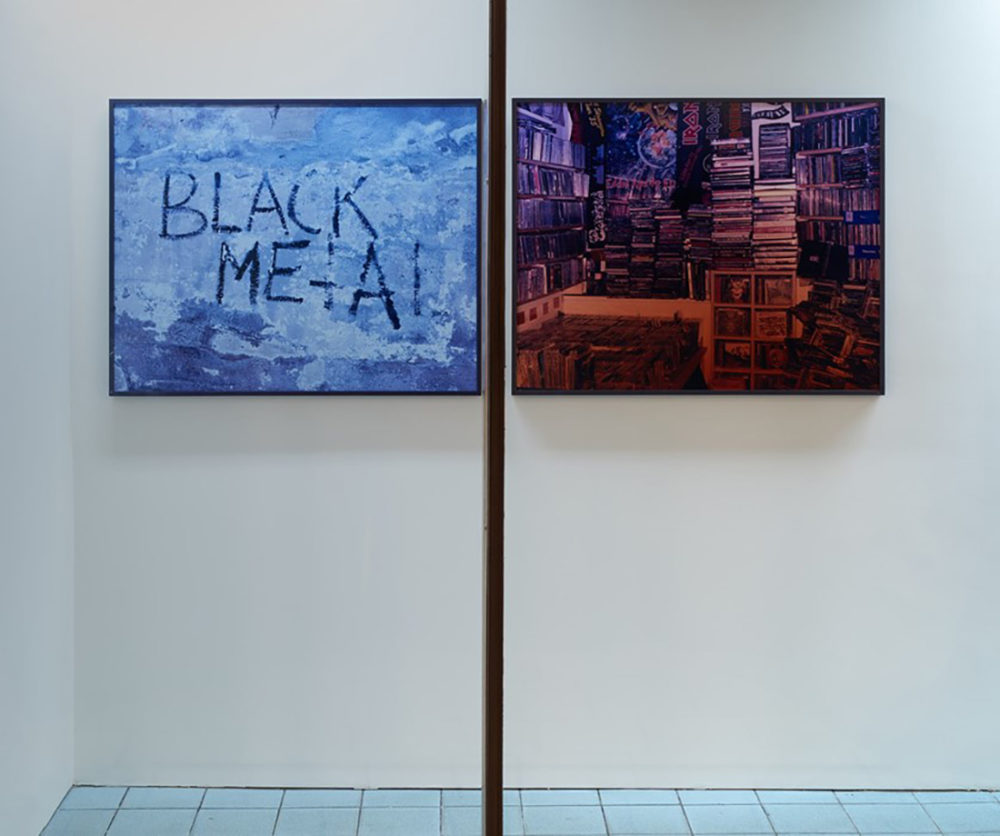
- Source: Dazed Magazine
- Author: Antonia Marsh
- Date: May 03, 2018
- Format: DIGITAL
There’s a heavy metal show going on in a London tube station
Dazed 100er and curator Antonia Marsh sits down with artists Grace Ahlbom and Willie Stewart as they muse on the subculture and the visual vernacular of heavy metal

Photograph by Rosie Marks
There’s a heavy metal show going on in the middle of London, at Piccadilly Circus tube station. It’s the latest exhibition at Soft Opening, and brings together Grace Ahlbom and Willie Stewart to present five artworks between them. Three photographs from Ahlbom feature alongside one sculpture and one wall-based work from Stewart in I Can Dream, Can I Not? Dreaming is Heavy Metal – a show that examines and unpacks the visual vernacular of heavy metal. Ahlbom’s images shot at Helvete – the famous a record-store-turned-museum that is widely considered the birthplace of the black metal genre – continue the artist’s fascination with fandom, boredom, and the fetishisation of subculture. Concurrently, Stewart’s three-dimensional investigations reflect on memory and hope. Viewed through a layer of glass, the works take on new meanings and reveal how constructed memory can be. The result feels like a shrine to objecthood, where VHS tapes and CDs of a bygone era become relics of nostalgia that seductively posit heavy metal as a nuanced arena for critical thought. Whether manipulating space, scale, or the visual codes that emblematise our understanding of an artwork, Ahlbom and Stewart situate the viewer both inside their constructed fantasies and from the outside looking in, teasing out their anxieties felt as either a voyeuristic outsider – or keen disciple – of this particular niche subculture.

Photograph by Theo Christelis
This exhibition isn’t the first time you both connected over your work. When did you first meet?
Willie Stewart: We met a couple of years ago at my studio at Pioneer Works in Brooklyn. Grace came by and we immediately connected when she showed me her work.
Grace Ahlbom: We were talking about the shape of the Warlock guitar that I’d made out of cut walnut which, of course, Willie immediately recognised.
Where did the idea of the show engaging with heavy metal originate?
Grace Ahlbom: Originally, from a curatorial perspective, it organically came to engage with heavy metal more than it was originally intended to. I first started thinking of Willie’s VHS tapes in relation to my images of Helvete, because I was interested in ideas of reproduction and repetition, but I soon learned that you don’t pick and choose a specific work, it’s the artist that suggests what they’re going to show. It wasn’t until after we showed you my images that you proposed the heavy metal VHS tape work, and it was at that point that the show took on even more engagement with that kind of visual vernacular.
Willie Stewart: I had a reaction to the prompt. I started thinking about a work that I really wanted to make that I had never had a chance to. In this show, heavy metal is sort of like the skin. There’s not really heavy metal in the blood, you know?
Grace Ahlbom: Even the words “heavy metal” in your piece aren’t even directly relating to the music genre: they’re just from a magazine.
If the show was literally about heavy metal, it would be strange to have the word heavy metal visually included like it is. It’s almost precisely because it isn’t about heavy metal, that that VHS can be in there.
Willie Stewart: The thing about heavy metal and the reason why I made that piece is also the reason I named the piece “Some Scarecrows Have Lost Their Scare”. Heavy metal is nothing anymore. There’s not really much left in it – there’s not any scare left in it. It’s an attitude maybe, but I think even that’s too generous. To me, it’s more of an idea of a moment in one’s life, an attitude that’s created to sort of have a rupture in oneself. I think it’s interesting, I think you need it. I think people need heavy metal, but heavy metal doesn’t do much for anything anymore. And the reason why it doesn’t do much for anybody anymore is because it can only be understood as a trope and a genre. Someone just sees it and takes it at face value. No one’s trying to pervert it. Heavy metal is just a style. The most pictorial way I think about it starts with a scarecrow, then the bird lands on his shoulder and he looks into the landscape: he’s not afraid of the scarecrow anymore. The face paint, all of it, becomes just an image. I think that’s why heavy metal interests me.
Grace Ahlbom: Did heavy metal ever scare you at one point?
Willie Stewart: No.

Photograph by Theo Christelis
This idea of the language of heavy metal becoming much more accessible to the mainstream or diluted in some way really relates to your work too, Grace. To the work in the show, but also the work that you shot outside the show, but still part of this same project. The images of the two figures roaming around London covered in Kiss makeup, for example.
Grace Ahlbom: In this shoot, I was performing the fan culture that I had been observing, but that I’m definitely seeing from an outsider’s perspective. And that’s also how I felt at the record store when I shot the interior images in the show.
How did your project come about in the first place, Grace?
Grace Ahlbom: I was in Norway and I went to visit Helvete, which is a record store known for being considered by many as the birthplace of black metal as a genre. The store is now pretty much a museum filled with metal ephemera and floor-to-ceiling stacks of CDs and T-shirts but hardly any of it is for sale so it has this sort of shrine-like museological quality to it. I typically shoot still lives or landscapes and so this felt like a combination of the two – a still life because it’s a collection of objects but a landscape because I didn’t have to edit the composition at all, it was completely ready-made. I felt like I was going through someone’s basement, full of relics from when I was a kid.
In our conversations surrounding the show, we have talked a lot about how the glass that separates the viewer from the exhibition affects the artworks, as well as our behaviour in response. How does the space affect the work?
Grace Ahlbom: It’s so weird because it’s a window display, I keep thinking of it as a small space, but even my pieces which I thought were big, look small.
Willie Stewart: The space interests me because of its brightness, and the fact that it’s around the corner of those stairs: it becomes a point of fascination. When we were inside the space installing, it became a performance, everyone was stopping. The glass provides a sort of layer in front of the work. Set in this ambulatory space where people need to from point a to point b, it becomes about fascination.
What I really liked about the photos in this space – all displayed on the same plane – is how it conflates interior and exterior and confuses background and foreground. Then Willie’s sculptures mess with scale. Overall the show presents a pretty radical proposition of space and scale. With this in mind, if you were to think about what conversation your works are having with each other, what would you say?
Grace Ahlbom: My images are so flat and Willie’s are so three-dimensional, it feels like you are plucking the VHS out of my image and it’s ballooned to cartoon size so you can walk around it. It reminds me of the Natural History Museum in a way because it feels like a giant diorama with my work as the background.
Willie Stewart: When I think about how our work works together, I think of it as essentially functioning in the same way but just on different frequencies of criticality. All the work in the show, all my work and all yours is all pointing at something. Some works are pointing really hard and others are pointing much slower, but I think what’s interesting is how that comes together to create some kind of tempo or frequency that makes an overall picture.
Grace Ahlbom: I appreciate what you said about pointing. Photography is a way of curating the world. You’re telling people: look here, look here, look here. Just like when you show someone a photograph, in the work you’re making you’re replicating things that already exist in the world, but you’re bringing so much significance to them because you’re remaking it and you’re asking people to really look. It’s all pointing.
Willie Stewart: And each artwork suggests something else. Taking the picture of the wall and putting it on the wall again can be unpacked deeply and there’s something interesting in how a reliquary or a shrine works in a similar way. You build this space for something that you look unto. Photographing that famous graffiti on the wall at Helvete and then moving it transforms it into a transitory version of itself. It reminds me of certain religions where you are encouraged to pray to a certain direction, and then you create a space in your house that directs that prayer. Religion is interesting to talk about in relation to black metal because metal is always constantly critiquing religion. There’s upside-down crosses or dissected Jesuses… But if we take Helvete, it’s a museum but it’s become a reliquary that people take a pilgrimage to see Euronymous’ (guitarist and founder of the early Norwegian black metal scene) handwriting on the wall. What you’ve done is make it portable, turn that image into something that you can move and take around, that like feels like an altarpiece. So the funny thing is, metal doesn’t seem so far off from religion itself.

Photograph by Theo Christelis
Both your works engage with the still life as a traditional genre of image-making. This is particularly interesting because still lives were so rich with visual codes and symbolism. Often artists wanted their audience to literally read their paintings. You both similarly ask your viewers to read your works: whether the text on your VHS tape or The Smiths lyric on the book page, Willie; or the writing on the wall, poster or ephemera in the store, Grace.
Grace Ahlbom: Actually the stacks in that interior image of Helvete are illegible. There are moments where I wish they were more easily legible but I think their illegibility complements the trope in metal typography where the text is hard to decipher. This is deliberate and aims to slow the reader down, which is so contrary to how we consume images today. I worked with graphic designer Benjamin Ganz on the typography for the exhibition and we applied the same logic.
Willie Stewart: What I was always interested in is the stacking and collaging of stuff, especially paintings that come off the wall, because they have a porosity to them. It’s not a locked viewpoint like a flat painting is locked, I can never see this painting here other than what the artist wants me to see, right, but to move off the wall and become dimensional, is to create many different vantage points and you can move around. So there’s this idea of seeing something new based on how you physically approach the work.
It’s nice that you can kind attempt to read the image, but you almost aren’t allowing people to, it’s a tease. What visual codes are your artworks in this show constructed from?
Willie Stewart: Visual codes propose the hope and desire that a painting exists beyond its frame, that the meaning of an artwork can be bigger than simply how it appears before us. Metal definitely doesn’t do that, metal is locked down. The VHS tape is nothing more than memory, it’s a device that holds a memory but it’s scarred by the idea of its technological obsolescence. That it won’t last forever.
Grace Ahlbom: I was thinking how important it is that objects hold memory and how everything we receive in terms of visual information is through our screens. So how will our memories be triggered in 30 years from now? Not by objects like VHS tapes or CDs anymore, but by images on a screen? I can’t imagine, in however many years from now, looking through a basement, what are you even gonna find?
Willie Stewart: The thing about the screen though is that its obsolescence is actually really quick, you change these phones every year. But the information you look at on them is timeless. We have this idea that there’s a democracy to this information we are presented with, but, of course, there’s the potential that in reality, it’s more sinister than that. The thing about a VHS tape is that, just like us, it has an expiration. It becomes like the human body. We will all expire: we’ll fade and we’ll drift and we’ll forget. And maybe we’ll forget the things that we love the most and maybe we’ll forget what happened yesterday because we don’t give a fuck about it anymore.
I Can Dream, Can I Not? Dreaming is Heavy Metal runs at Soft Opening – located in Piccadilly Circus tube station – until May 6, 2018

